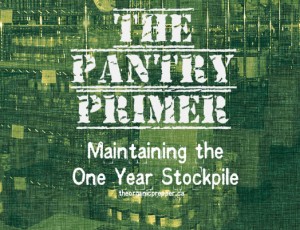
After 3 months of careful budgeting, shopping, food preservation, repackaging, and stockpiling, we now have a one year food supply. This doesn’t mean that we don’t have to shop for a year, but it does mean that we have a cushion against disaster, whether it be personal, regional, financial, or natural. It gives us the freedom to wait out price spikes and purchase items on sale or in bulk. It means fewer trips to the store (and less temptation to go off-budget). It means that when scanning new recipes I nearly always have the ingredients on hand to make the delicious goodies that I find.
Once you’ve built your pantry, you have to develop a plan to maintain it. You don’t want to end up back at square one a year from now!
Using your stockpiled items
First of all, you bought this food to eat. While some items might be stored for many years in case of a dire, long-term emergency, most of these foods should be rotated into your kitchen and replaced as needed.
- When you store your foods, always place the oldest items with the closest expiry dates at the front. Place newly purchased items at the back.
- Before your grocery shopping trips, check your pantry first. Do you have home-canned goods that need to be eaten? Is there a bag of pasta that is nearing expiration? Work those into your menu plan before shopping.
- Speaking of menu planning, decide ahead of time what you plan to serve that week. You may discover that you actually need very few items, freeing up your budget for sale purchases that replenish your stockpile.
- When your stockpile is properly maintained, your weekly purchases should only be for fresh produce and dairy products. The remainder of your budget can go to make large buys of sale items with which to replenish your pantry. Use your stockpile for the basics like pasta, meat, baking supplies, and soups.
Maintaining your one-year pantry
Once you’ve created your pantry, it is important to maintain it. You don’t want to deplete your food stockpile without a plan to replenish it. Although items that you purchase seasonally will drop throughout the year, you need to maintain a certain level of pantry basics.
- Keep a running inventory. If you don’t know what you have, you don’t know what you need. I created an Excel document on my computer for this. Some people keep a clipboard in the pantry with a printed list that they update when they take items for kitchen use.
- When staple items drop to a certain point, begin looking for a good deal.
- Stockpile seasonally. During harvest season, focus on preserving fresh fruits and vegetables for later in the year. In the winter spend your money on grain items and pantry basics purchased in large quantities. In the fall, make bulk meat purchases, like a half cow or half pig.
- Track the sales cycles throughout the year in order to purchase staples when they are at the lowest prices. There is a very distinct and predictable pattern to these good buys. For example, baking supplies nearly always go on sale just before Christmas, canned goods drop in February, etc. Learn more about annual sales cycles HERE.
- Keep a price book to help you track the cost of various items in your area. This will help you to know whether a deal is as good as it is promoted to be. Stockpile shopping, when done right, can save you a fortune in annual food costs.
- Pay attention to your repackaging practices. Your purchases are only as fresh as your storage methods. (Go HERE for a refresher course on food storage best practices.) There’s nothing worse than grabbing something from your stockpile, only to find that it is stale or full of bugs. If your foods are not stored properly, your money has gone to waste.
Expand your stockpile beyond food
You don’t have to limit your stockpile to all things edible. You can apply your stockpile principle to save money on many other items. Here are a few examples of other stockpiles that we keep in our home.
- Shower gel
- Soap
- Laundry products
- Shampoo and conditioner
- Disposable razors
- Band-aids and other First Aid supplies
- Dish soap
- Feminine hygiene items
- Toilet paper
- Cosmetics
- Coconut oil
- Peroxide
- Rubbing alcohol
- Hand sanitizer
- Bleach
- White vinegar
- Cleaning supplies
- Garbage bags
- Kitty litter (for emergency sanitation)
- Pet food
- Flea and tick medication for pets
- Tea tree oil
In case you missed them, here are the other articles in this series:
The Pantry Primer: How to Build a One Year Food Supply in Three Months
The Pantry Primer: Grocery Outlet Victory
The Pantry Primer: Meal Planning While You’re Building Your Stockpile
The Pantry Primer: Getting Started
The Pantry Primer: Building Your Pantry on a Budget with Home Canning
The Pantry Primer: Adding Larger Purchases to Your Stockpile
The Pantry Primer: 12 Strategies to Build the Ultimate Pantry
The Pantry Primer: Building Your Protein Stockpile
The Pantry Primer: Stocking Your Supply of Fruits and Vegetables
The Pantry Primer: Stockpiling the Basics for Scratch Cooking
The Pantry Primer: Stockpiling Grains


























